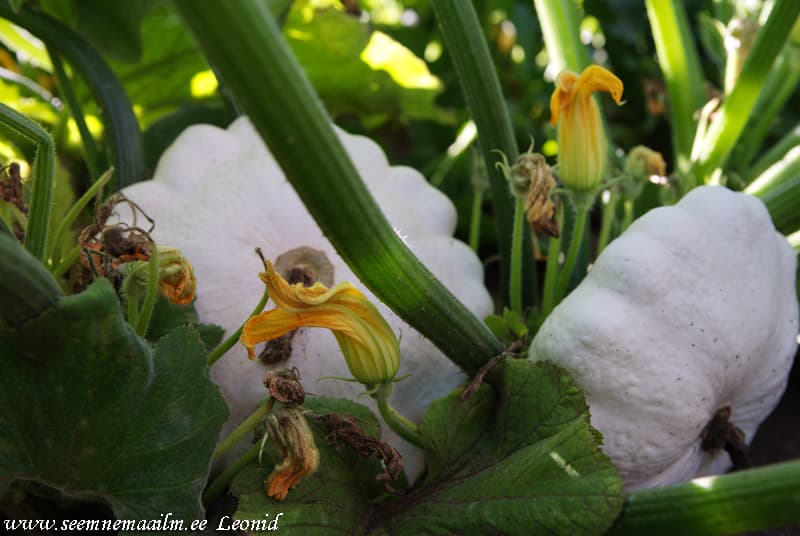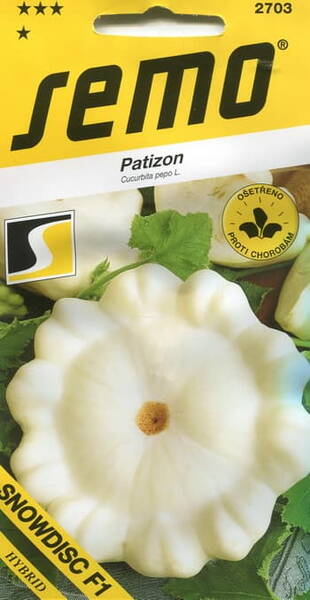Early hybrid, 42-45 days from germination to first harvest. Bush plant, compact. The fruits are white, 20-22 cm in diameter, weighing 250-300 g. Excellent delicate taste.
* Preparing squash seeds for sowing.
Squash seeds are large (1 g = 7-9 pieces).
Attention! The sowing qualities are better in 2-3-year-old seeds.
Before sowing, squash seeds are treated with a strong solution of potassium permanganate for 15-20 minutes. Then the seeds are washed in water and dipped in a solution of wood ash for 24 hours (for a 0.5-liter jar of water, take a tablespoon of ash).
Then the seeds are rinsed with water and left in a damp cloth for another 1-2 days at a temperature of +20+25°C, after which the seeds are ready for sowing. Pre-sowing warming, which can be done in an oven or thermostat for 4-6 hours at a temperature of +50+60 °C, will help prevent viral infection.
You can also warm the seeds for several days in the sun. Then, it is necessary to select the most mature seeds by placing them in a 3-5% solution of table salt for 15-20 minutes. After this, drain the water along with the floating seeds, and rinse and dry the seeds that have settled to the bottom.
You can speed up the germination of seeds by soaking them in 0.002% boric acid (20 mg per 1 liter of water). In this solution, the seeds are kept for 12-24 hours at room temperature. Soaking should be done in gauze bags, and then the seeds should be rinsed in clean tap water and dried.
It is also necessary to harden the seeds (they are moistened, placed in gauze bags and kept alternately at a temperature of +18+20 °C for 6 hours and at 0+2 °C for 18 hours, periodically moistening and stirring for 3-5 days).
Growing seedlings.
Seedlings are grown 15-20 (or 40) days before planting in the ground. In the latter case, there should be no more than 20-30 plants per 1 sq. m. Seedlings are grown in peat-humus cubes measuring 10x10 cm. They are prepared from garden soil, peat and loosening materials (10-15% straw, sawdust, etc.) with the addition of ash (30-50 g per bucket). It would be a good idea to add complete mineral fertilizer to the prepared mixture.
Sprouted seeds are sown in pots (2 in each). After the shoots appear, the weaker plant is cut off at soil level. You can first sow the seeds in steamed sawdust. After the shoots appear, they are picked one by one into a pot. Seedlings are planted in the ground when they have 2-3 true leaves.
For growing squash, experts recommend using both methods: sowing in the ground and using seedlings. The fact is that if squash is grown only by sowing in the ground, it is a good idea to have an insurance fund of seedlings (up to 20% of the total number of plants that are supposed to be there). If the seedlings have suffered from frost, pests, diseases, or simply have not taken root well, it is necessary to sow seeds in place of the fallen plants.
Preparing the site and sowing seeds in the ground.
Squash is sown in an open, well-heated and ventilated bed. It is better to cultivate the soil in the fall. Organic fertilizer should be added to the site and then dug over without breaking up the clods of earth. Early in the spring, as soon as the snow melts and the soil dries out, the clods should be broken up and the surface leveled with a rake. If organic fertilizers have not been applied since autumn, they should be applied in the spring simultaneously with mineral fertilizers, a week before sowing, followed by digging the area to a depth of 18-20 cm. After this, the bed should be raked. If the soil is acidic, lime is applied in the fall.
The bed for squash is made narrow (50-60 cm wide). The soil is leveled and compacted, then watered with warm (+40°C) water (5 l per 1 sq. m) and covered with film. After 3-5 days, the film is removed and sowing begins. In Estonia, sowing is usually done in the 2nd-3rd decade of May. It is also possible in early June.
When using insulated beds or film shelters, sowing is carried out two weeks earlier. The seeds are embedded to a depth of 5-7 cm on light soils and 3-4 cm on heavy soils. If the weather is very dry, the beds should be compacted to cause an influx of moisture to the roots from deeper layers. 1-2 plants are placed per 1 sq. m. The sowing pattern is 60x60 cm, the seeding rate is 0.5 g of seeds per 1 sq. m.
Care, watering and fertilizing.
In film greenhouses, squash is grown as seedlings on a vertical trellis. Garter is done in the usual way. Lateral shoots are removed at a height of up to 50 cm; from 50 cm to 1 m, one node and fruit are left, then up to the height of the trellis, 2-3 nodes and fruits are left. When the plants reach the height of the trellis, they are wrapped twice around the wire and tied, the free end is lowered down. At a height of 50 cm from the soil surface, the main shoot is pinched.
During the growing season, squash in greenhouses is regularly watered, weeded, and the lower aging leaves are removed. Watering is done along furrows (water should not get on the ovaries and flowers, since they rot when over-moistened). During the growth period, 1-2 fertilizings are carried out with solutions of mineral fertilizers. Effective top dressing with mullein (1:10) and chicken manure (1:20). The solution is used at 0.5 l per plant. You can get by with one such top dressing.
In closed ground (in any weather), manual pollination is carried out. To do this, pick a male flower (empty flower), tear off the corolla of the flower and insert it into the female flower.
In open ground, caring for squash plantings consists of watering the soil under the plants, weeding, removing the lower aging leaves and fruits affected by rot. To protect crops from diseases and prevent rotting of the ovaries, water the squash only along the furrows. Squash almost do not need pinching or any kind of shaping. However, if the vegetative mass has grown strongly to the detriment of the fruits, then in the morning in sunny weather you need to cut off 1-2 old leaves. After 3-4 days, this operation is repeated once more.
Squash is not loosened or hilled. However, when watering, the roots of the plants are often exposed, so 1-2 times during the growing season, peat, humus or any soil mixture must be added under the bushes.
Squash loves moisture, especially during the fruiting period. Water the plants with settled warm water (+22+25°C). Before flowering - 5-8 liters per 1 sq. m every 5-6 days, during flowering and fruiting - 8-10 liters per 1 sq. m every 3-4 days. During the growing season, squash plants are fed three times. The first feeding is carried out before flowering: a tablespoon of complete fertilizer is diluted in 10 liters of water and watered at the rate of 3-5 liters per 1 sq. m. During fruiting, the plants are fed twice. In 10 liters of water, dilute a 0.5-liter jar of chicken manure, a teaspoon of urea and potassium sulfate and water at a rate of 5-6 liters of solution per 1 sq. m. The same feeding is repeated after 12 days.
To prevent slugs from damaging the ovaries, and to prevent them from rotting, it is advisable to isolate the fruits from the ground by placing plywood, a board or glass under them.
Harvesting and storage.
Usually, squash is harvested unripe, when its seeds have not yet formed. Fruit harvesting is carried out 2-3 times a week, when the fruits reach either 5-7 cm (for dessert use and canning whole fruits), or 7-12 cm (for salad and table use and canning in slices). With regular harvesting of fruits, squashes bear fruit until the first frost, after which the plants are removed and used in green compost. Squash can be stored for no more than 10 days at a temperature of +1+2°C.
Attention! Overripe fruits delay flowering and the formation of new ovaries, as a result of which underdeveloped ovaries may crumble.
Obtaining your own seeds.
To obtain purebred seeds, at the beginning of flowering of plants, a female and male flower are selected for pollination, isolated and artificially pollinated in the same way as cucumbers; the female flower is marked with a bright piece of cloth or colored thread. The ripened fruit is removed before the onset of frost, ripened in room conditions for 2-3 weeks. Then the seeds are cut, separated and washed, dried and stored in bags at room temperature. The weight of 1000 squash seeds is 65-85 g.

Fruticose squash, Scallop squash, Patisson. Bot.: Cucurbita pepo L. var. melopepo.












